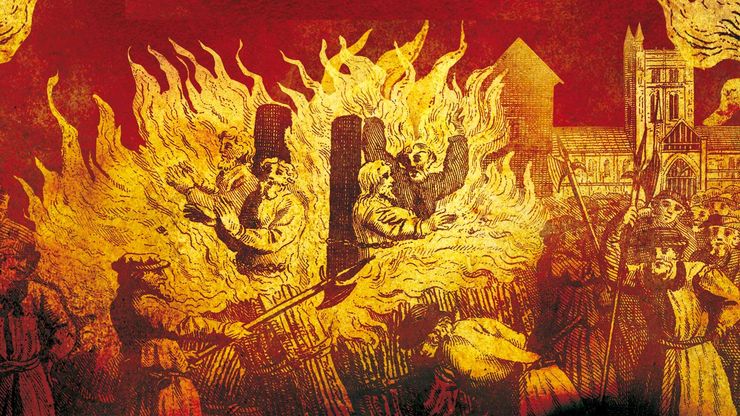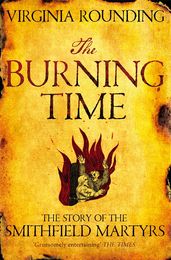The true story of the Smithfield martyrs
Virginia Rounding introduces the stories of the Smithfield Martyrs as told in her book, The Burning Time.

Virginia Rounding’s The Burning Time tells the true stories behind some of the key players in C. J. Sansom’s Lamentation and Hilary Mantel's Wolf Hall, including those of Anne Askew, Richard Rich and Thomas Wriothesley.
The Burning Time is the story of the hundreds of men and women who were burned at the stake for heresy by the Tudor monarchs. It offers a gripping insight into a time when people were willing to die, and to kill, in the name of religion.
Here, she introduces the stories of the Smithfield martyrs.
Anne Askew was burnt at the stake along with John Lascelles (a lawyer and Gentleman of the King’s Privy Chamber), John Hadlam (a tailor from Essex) and John Hemsley (a former Francis-can friar), on 16 July 1546. A great stage was built at Smithfield for the convenience of Chancellor Wriothesley, other members of the Privy Council and City dignitaries, to watch the burning in comfort. Anne herself, having been broken on the rack, was unable to stand, and was chained to the stake in a sitting position. John Louth, the Archdeacon of Nottingham, who witnessed the execution, described Anne as smiling throughout her torment and looking like an angel, and insisted that, at the moment of her death, there was ‘a pleasant cracking from heaven’. Whether that was the sound of the flames, or summer lightning, or merely a figment of the imagination, cannot now be determined; nor can we know how, or if, the witnesses could actually have identified the precise moment of death.
So what was the terrible crime that Anne was deemed to have committed and that led her to this appalling end? Why was being a ‘Protestant’ or ‘reformer’ considered so heinous, and what was this ‘heresy’ with which she was charged?
A word deriving from the Greek, ‘heresy’ originally meant merely ‘choice’, but by the Middle Ages it had come to mean ‘wrong choice’, especially in matters of religion. In Europe, and particularly Spain, the ‘Inquisition’ had been set up to identify heretics, with the aim of their contaminating heresy being cut out of society, like a cancer. Heretics were given one chance to ‘abjure’ or ‘recant’ – effectively, to make a public confession that they had been wrong, to accept some kind of ‘shaming’ penance (such as standing in front of a church congregation wearing a white sheet or being paraded through the streets on a cart), and to agree to follow ‘orthodox’ belief (‘orthodoxy’ meaning both ‘right doctrine’ and ‘right worship’) from now on. If a heretic, having recanted, fell back into his or her old ways, there was to be no second chance. They were to be handed over by the Church to the civic authorities for punishment – which meant death by burning.
But the nature of what constituted heresy kept changing, particularly in England during the tumultuous years of the mid-sixteenth century. There were several types of possible heretical belief under the respective reigns of the three monarchs which constitute the burning time (the period which saw the greatest number of burnings for heresy) in Tudor England – Henry VIII, Edward VI and Mary I. Some were based entirely upon interpretations of religious doctrine; some hinged on changes in society and questions of authority and were linked to the increased availability of the printed word; others were dictated by the whim of the individual monarch.
Purely religious heresies were associated with the new doctrines of Protestantism, originating from the teachings of Martin Luther and others. Luther’s central doctrine was that of ‘justification by faith alone’, which implied that the whole paraphernalia of the traditional Church, with its pilgrimages, processions and prayers to saints, was at best unnecessary and at worst wicked and a form of idolatry. The nature of priesthood was also called into question, including whether or not priests should be celibate. But the most important issue in the religious disputes of the time – and the one on which the fate of Anne Askew hinged – concerned what was believed to take place during celebrations of the Eucharist, or the Mass (or what Protestants referred to as Holy Communion). In the mid- 1540s, to declare in the wrong quarters that the Eucharist was a commemoration of the sacrifice of Christ, rather than a sacrifice in itself, was to risk one’s life.
For the Protestant, or evangelical, reformers, the ‘word’ (that is, the Bible – rather than the Catholic emphasis on ‘the Word of God’ as Christ himself ) took precedence over the Mass. One of the things which most disturbed the orthodox about the teaching of Luther and his followers was that it involved ordinary people being encouraged to read the Bible, in their own language, for themselves. Previously, the faithful would only have heard selected extracts from the Bible, in the context of church services, being said or chanted in Latin (though there was a move, in the late 1530s and under Henry VIII’s authority, for English versions of the lessons – or readings – at Mass to be read out after the Latin). It was for the priest to understand the content of the Bible, as interpreted by the traditions of the Church, and for him to convey that interpretation to his flock. It was not up to his flock to decide for themselves what the word of God meant: so at least the hierarchy thought, and this became one of the main strands of opposition to the ‘Gospellers’, as the Protestants were sometimes known.
The centrality of the question of authority also helps to explain why heresy was often closely aligned with treason. If people were allowed to interpret the scriptures for themselves, without the mediation of legitimately authorized priests and theologians, anything could happen – or so it seemed to those desperate to preserve (for reasons either of power or of genuine belief, or of a combination of the two) the approved interpretation as the only possible truth. Sir Thomas More, for instance, was convinced that such a relaxation of ecclesiastical authority and of inherited systems of belief would unleash mayhem on the world and lead to the collapse of the entire social order.
In the time of the Tudor monarchs and before, most people maintained an unquestioning belief in the virtue of obedience to authority, whereas we, especially in the Western hemisphere, have now become very unused to the idea of authority being exercised over us – particularly over elements of what we consider to be our personal lives, of which our religious or spiritual beliefs (or lack of them) are seen as the most personal and private. But for many people living under Henry, Edward or Mary (and later under Elizabeth), having to negotiate the changes and chances of each reign, the most natural reaction to religious laws was to obey them with as little question – but maybe with as much covert grumbling – as the laws dictating which classes of people could wear which sorts of dress. This was what it meant to be a subject, and obedience, at least in outward things (including speech), was the surest way to survive. If you are used to being told what to wear (and sumptuary laws, or ‘acts of apparel’, were still being rigorously enforced in the reign of Elizabeth), perhaps you will also accept being told what to believe – at least until you begin to discover for yourself that what you are being told may not be right, or at best may not present the complete picture. This is the kind of realization that came to Anne Askew and people like her, a realization fostered by their own reading.
Of the three monarchs whose reigns span the burning time, it was at least possible to know where Edward and Mary stood and therefore, in theory at least, to avoid ending up on the wrong side. They were, however, diametrically opposed – Edward being a firm, some might say bigoted, Protestant, while his half-sister Mary was a correspondingly staunch Catholic. So to remain ‘orthodox’ when one reign succeeded the other, their subjects had to perform some extreme voltes-face. Henry was more of a problem. It could be argued that he was responsible for the initiation of the whole process of heresy-hunting in England, as it was he who split off the English Church from Rome. Though his motives were primarily bound up with his desire to have his marriage to Katherine of Aragon annulled so that he could marry Anne Boleyn and have an heir by her, he also had some sympathies with the ‘new men’ or Protestants, particularly during the years he was in love with Anne, as she was herself a Protestant sympathizer. But on the other hand, Henry remained largely faithful to most Catholic doctrine, and it was mainly for falling foul of traditional religious beliefs – as Anne Askew did – that ‘heretics’ were burnt during his reign.
Burnings typically took place on a wooden platform, some three feet from the ground, on which the victims were bound to the stake by chains. Bundles of brushwood, rods and sticks tied together to form ‘faggots’ – more usually used for kindling in the domestic hearth, or as the principal fuel of the city’s bakeries and brew- houses – were stacked around the victims’ legs, and the official in charge of the proceedings – sometimes the Lord Mayor of London – would cry out ‘Fire the faggots!’ and ‘Let justice be done!’ as the signal for the executioner to light the pile of wood with a flaming torch. There would always be a crowd gathered round (though not too close) – some sympathizers there to support the victims, others come to enjoy the spectacle – all waiting for the moment when the bodies, charred and melted by the flames, would topple over from their chains and into the fire. The faggots were intended to kindle quickly to produce a short hot blaze, before flesh and body- fat provided fuel for the fire. But every burning was different; if the fire ‘caught’, it could be over relatively quickly, but on damp days, or when the wind persisted in blowing the flames away from the body, it could take up to an hour for the condemned person to die, an hour of excruciating agony.
Of the burnings which took place in England between 1529 and 1558 by far the largest number occurred in one small area of London – the area known as (West) Smithfield. Just outside the City walls though still within its bounds, not far from Newgate prison, ten minutes’ walk from both the Guildhall and St Paul’s Cathedral on Ludgate Hill (the old pre- Fire of London cathedral, over 600 feet in length and with a spire rising to some 500 feet), this was a convenient place to take people to die, with space enough to erect viewing stands from which ‘the great and the good’ could watch the spectacle. Smithfield, originally known as ‘Smoothfield’, had been a place of public execution for over 400 years; many witches and heretics had been burnt, roasted or boiled alive there. It was here that the Scottish hero and patriot, Sir William Wallace, was hanged, drawn and quartered in 1315, and where Wat Tyler, the leader of the Peasants’ Revolt, was fatally stabbed by the Lord Mayor in 1381. Many tournaments had also taken place there, royal jousts having begun in Smithfield in the reign of Edward III (1327–77). The other activity for which the area was (and is) famous was the craft of butchery, meat having been traded in Smithfield since the tenth century.
Adjacent to the open space of Smithfield was the great Augustinian Priory of St Bartholomew, one of the City’s most important monasteries. The annual Bartholomew Fair was held on the priory’s land, attracting all manner of people – cloth merchants from all around Europe mingling with jugglers, acrobats, inn-keepers and pickpockets. It was also an area which drew the poor and the sick, the monastery’s sister- foundation, St Bartholomew’s Hospital (still world-famous as ‘Barts’), offering relief for the body while the prior and canons (as the members of an Augustinian community were known) offered prayers for the soul.
Of the 288 people estimated to have been burnt for heresy during the five- year reign of Mary Tudor, forty- eight were burnt in Smithfield. The next-highest numbers were eighteen in Lewes in Sussex, seventeen in Stratford-atte-Bow (now Bow in East London), fourteen in Canterbury and seven in Maidstone (both these latter in the county of Kent). Some seventeen people had suffered the same fate in Smithfield under Henry VIII, as had two ‘Anabaptists’ (extremists whom even Protestants regarded as heretics) during the brief reign of Edward VI.
However interesting, and harrowing, the lives and deaths of individual ‘martyrs’ (and the meanings of that emotive word will be considered in due course), my hope is that this book will be more than a compilation of biographies. During the time I have been working on it, the questions that the stories of the Smithfield martyrs provoke have become ever more pertinent, the need for answers (if any exist) ever more urgent. What is it that makes people kill other people in the name of religion? Why are some people prepared to die – or kill – for their beliefs, while the rest of us are content to muddle along with compromise and uncer-tainty? What led to this ‘burning time’ in the history of England? Could it have been avoided and how was it overcome? Could it happen again? And, most importantly, is there anything we can learn from this dark period in our history to help bring an end to today’s deathly religious conflicts – or are we doomed to go on repeating the same mistakes, in different parts of the world, until we finally succeed in annihilating humankind altogether? The instances of heroism that emerge from the stories of the martyrs, the occasional glimpses of a different kind of light from that produced by flames, suggest it is worth struggling on.
The Burning Time
by Virginia Rounding
Spanning the reigns of British history's most remarkable dynasty, The Burning Time is a vivid insight into an era in which what was orthodoxy one year might be dangerous heresy the next.



